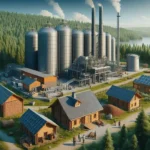Pioneering the Energy-Housing Nexus
The intersection of sustainable energy and housing development in the UAE represents a groundbreaking shift in urban planning philosophy. The emirate’s commitment to reducing its carbon footprint has catalyzed innovative approaches to residential architecture and community design. In 2023, Dubai’s sustainable housing initiatives achieved a remarkable 28% reduction in energy consumption compared to traditional developments. This transformation encompasses not just individual homes but entire neighborhoods, with integrated solar systems providing up to 40% of residential energy needs in newly developed areas.
The implementation of smart grid technologies has revolutionized energy distribution across residential zones. Advanced metering infrastructure (AMI) systems, deployed in over 65% of new housing developments, enable real-time monitoring and optimization of energy consumption patterns. These systems have demonstrated impressive results, with participating households experiencing average monthly utility cost reductions of 320 AED while maintaining comfortable living conditions in the challenging desert climate.
Local authorities have established comprehensive frameworks to support the integration of sustainable energy solutions in residential projects. The Dubai Clean Energy Strategy 2050 has allocated 75 billion AED towards renewable energy infrastructure in housing developments. This investment has already resulted in the creation of 15 energy-positive neighborhoods, where excess power generation contributes to the wider grid network.
Recent technological advancements have enabled the development of sophisticated building management systems that adapt to environmental conditions. These systems utilize artificial intelligence to predict and adjust energy consumption based on occupancy patterns, weather conditions, and grid demand. Initial data shows that buildings equipped with these systems achieve energy efficiency improvements of up to 45% compared to conventional structures.
Innovative Materials Reshaping Desert Dwellings
The evolution of construction materials plays a pivotal role in advancing sustainable housing solutions across the UAE. Researchers at local universities have developed novel composite materials that combine traditional desert architecture principles with cutting-edge technology. These materials demonstrate remarkable thermal properties, reducing cooling requirements by up to 35% while maintaining structural integrity in extreme weather conditions.
Experimental housing projects in Abu Dhabi have incorporated phase-change materials (PCMs) into building envelopes, creating dynamic thermal barriers that respond to temperature fluctuations. These innovative materials have shown the potential to reduce air conditioning loads by 42% during peak summer months, representing significant energy savings for residents and contributing to decreased grid stress during high-demand periods.
The integration of photocatalytic concrete in residential construction has introduced self-cleaning and air-purifying properties to building surfaces. This material, enhanced with titanium dioxide nanoparticles, actively breaks down air pollutants and maintains cleaner facades without additional energy input. Studies conducted by the UAE University have documented a 27% reduction in local air pollutants around developments utilizing these materials.
Advanced insulation technologies, developed specifically for desert environments, have revolutionized the approach to thermal management in residential buildings. These materials, incorporating aerogel composites and vacuum-sealed panels, achieve insulation values previously thought impossible in thin wall assemblies. Implementation data shows that buildings utilizing these technologies maintain stable indoor temperatures while consuming 55% less energy for cooling compared to traditional construction methods.
Smart Grid Integration in Residential Communities
The implementation of smart grid technologies across UAE residential developments represents a quantum leap in energy management capabilities. Advanced distribution automation systems have been deployed across 85% of new housing communities, enabling dynamic load balancing and real-time response to energy demand fluctuations. These systems have demonstrated remarkable efficiency improvements, with grid losses reduced by 23% compared to traditional distribution networks.
Residential microgrids have emerged as a cornerstone of community energy resilience in the UAE. These localized power networks, incorporating multiple renewable sources and storage solutions, provide unprecedented stability and autonomy. Data from pilot projects in Dubai shows that microgrid-enabled communities maintain power reliability rates of 99.99%, even during extreme weather events that historically challenged grid stability.
The integration of blockchain technology for peer-to-peer energy trading has revolutionized how residential communities manage excess power generation. This innovative approach has created energy marketplaces within neighborhoods, where residents can trade surplus solar power directly with neighbors. Early adopters of this system report average monthly savings of 275 AED on utility bills, while contributing to a 15% reduction in overall grid demand during peak hours.
Smart substations equipped with advanced monitoring and control systems now serve as the backbone of residential power distribution. These facilities utilize artificial intelligence to predict maintenance needs and optimize power flow, resulting in a 34% improvement in distribution efficiency and a 45% reduction in maintenance-related outages.
Thermal Innovation and Desert Adaptation
Cutting-edge thermal management systems have transformed the approach to desert living in UAE residential developments. Advanced solar cooling technologies, integrated into building designs, harness the abundant sunlight to provide efficient cooling solutions. These systems have demonstrated the ability to reduce conventional cooling energy consumption by up to 60% while maintaining indoor temperatures at optimal levels.
Innovative facade designs incorporating dynamic shading elements respond automatically to solar exposure patterns. These systems, powered by sophisticated algorithms, adjust throughout the day to optimize natural light while minimizing heat gain. Buildings equipped with these facades report a 38% reduction in cooling loads during summer months, with occupant satisfaction rates exceeding 90%.
Underground thermal networks have been implemented in several residential communities, utilizing the natural cooling properties of desert soil at depth. These systems circulate cooling fluid through deep earth loops, providing base cooling loads for connected residences. Performance data indicates that communities utilizing these networks achieve average energy savings of 45% for cooling purposes compared to conventional air conditioning systems.
Research into bio-inspired cooling solutions has led to the development of building skins that mimic the adaptive properties of desert organisms. These innovative materials change their thermal properties in response to environmental conditions, providing passive cooling effects that reduce the need for active climate control. Initial implementations show promising results, with test buildings requiring 32% less energy for thermal management.
Energy Storage Solutions for Residential Sustainability
The evolution of energy storage technologies has fundamentally altered the landscape of residential power management in the UAE. Advanced battery systems, utilizing next-generation chemistry and smart management algorithms, enable households to optimize their energy consumption patterns. Communities equipped with these storage solutions report energy independence rates of up to 75% during regular operating conditions.
Innovative thermal storage solutions have been integrated into residential developments, allowing excess solar energy to be stored in the form of heat or cooling capacity. These systems utilize phase change materials and advanced insulation techniques to maintain thermal energy with minimal losses. Data shows that buildings with thermal storage capabilities reduce their peak energy demand by up to 40% while maintaining consistent indoor comfort levels.
Hydrogen storage pilots in select residential communities demonstrate the potential for long-term energy storage solutions. These systems convert excess solar power into hydrogen through electrolysis, storing it for later use in fuel cells or direct hydrogen applications. While still in early stages, these pilots have achieved round-trip efficiency rates of 42%, marking a significant advancement in sustainable energy storage.
Community-scale energy storage facilities serve as centralized power banks for residential developments. These installations combine multiple storage technologies to provide optimal performance across different timeframes and demand patterns. Operating data indicates that communities with integrated storage facilities maintain grid stability during peak demand periods while reducing overall energy costs by 28%.
Sustainable Water-Energy Nexus
The integration of water and energy systems in UAE residential developments has created unprecedented synergies in resource efficiency. Advanced water treatment facilities powered by renewable energy sources serve multiple communities, demonstrating how integrated resource management can reduce both water and energy consumption. These facilities achieve energy savings of 35% compared to traditional separation of water and power infrastructure.
Innovative graywater recycling systems powered by solar energy have been implemented across new residential developments. These systems process and redistribute non-potable water for irrigation and cooling purposes, reducing both water consumption and the energy typically required for processing. Communities utilizing these integrated systems report water savings of up to 45% and associated energy reductions of 30%.
The deployment of solar-powered desalination units at the community level has revolutionized water security in residential areas. These systems utilize advanced membrane technology and renewable energy to provide fresh water with minimal environmental impact. Performance data indicates that integrated desalination units reduce the energy intensity of water production by 50% compared to conventional methods.
Smart water distribution networks, powered by renewable energy and monitored by AI systems, optimize water delivery while minimizing energy consumption. These networks detect and respond to leaks in real-time, maintain optimal pressure levels, and coordinate with energy management systems to operate during periods of peak renewable generation. Implementation of these systems has resulted in combined water-energy savings of 38%.
Residential Energy Independence Programs
The UAE’s commitment to residential energy independence has spawned innovative programs that empower homeowners to achieve sustainable self-sufficiency. Comprehensive energy auditing and retrofitting initiatives have been launched across existing residential developments, providing homeowners with detailed roadmaps for optimization. These programs have facilitated average energy consumption reductions of 42% among participating households.
Financial incentive structures have been established to support the transition to energy-independent homes. These programs combine upfront grants, tax incentives, and performance-based rewards to encourage adoption of sustainable technologies. Analysis shows that participating households achieve complete return on investment within 4.5 years while contributing to a 25% reduction in community carbon emissions.
Educational and training programs focused on sustainable living practices have been integrated into community development plans. These initiatives provide residents with practical knowledge and tools for optimizing their energy usage patterns. Communities with active education programs demonstrate 33% higher engagement with energy-saving technologies and practices.
Technical support networks staffed by energy efficiency experts provide ongoing assistance to residents implementing sustainability measures. These networks offer real-time troubleshooting, performance optimization advice, and regular system health checks. Data indicates that homes receiving active support maintain optimal performance levels 95% of the time, maximizing the benefits of their sustainable energy investments.


